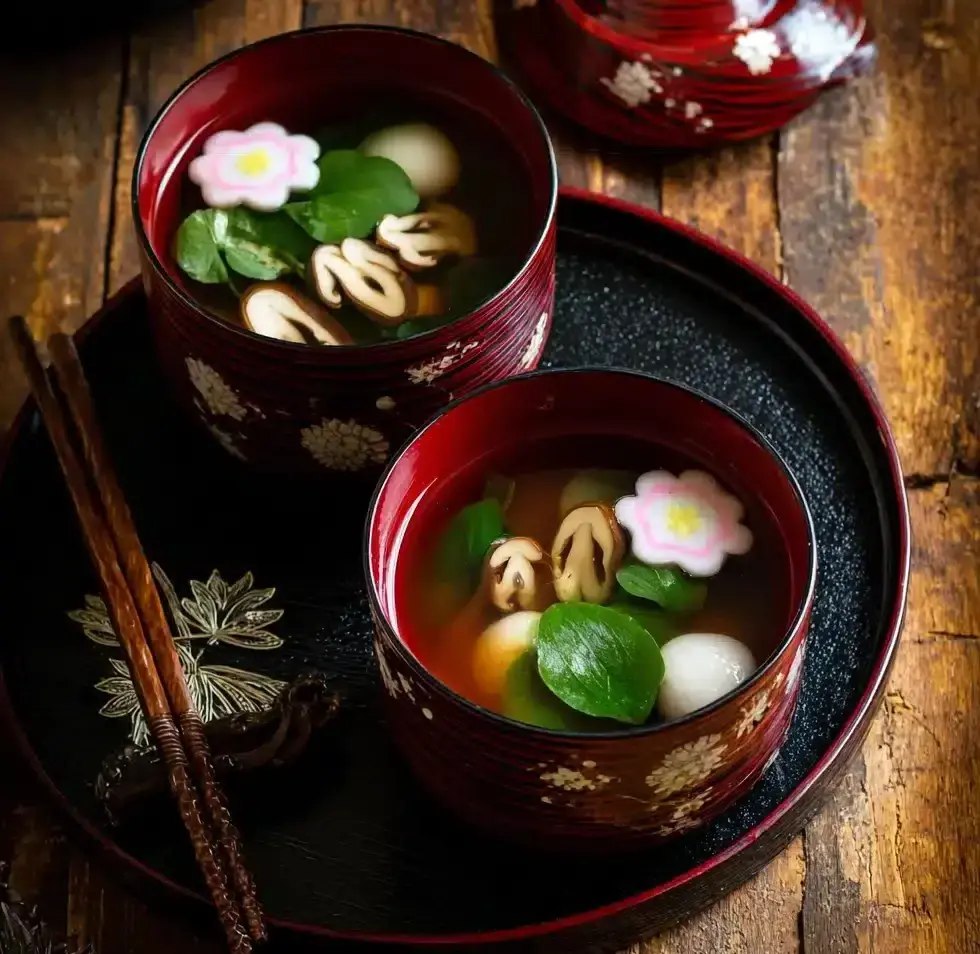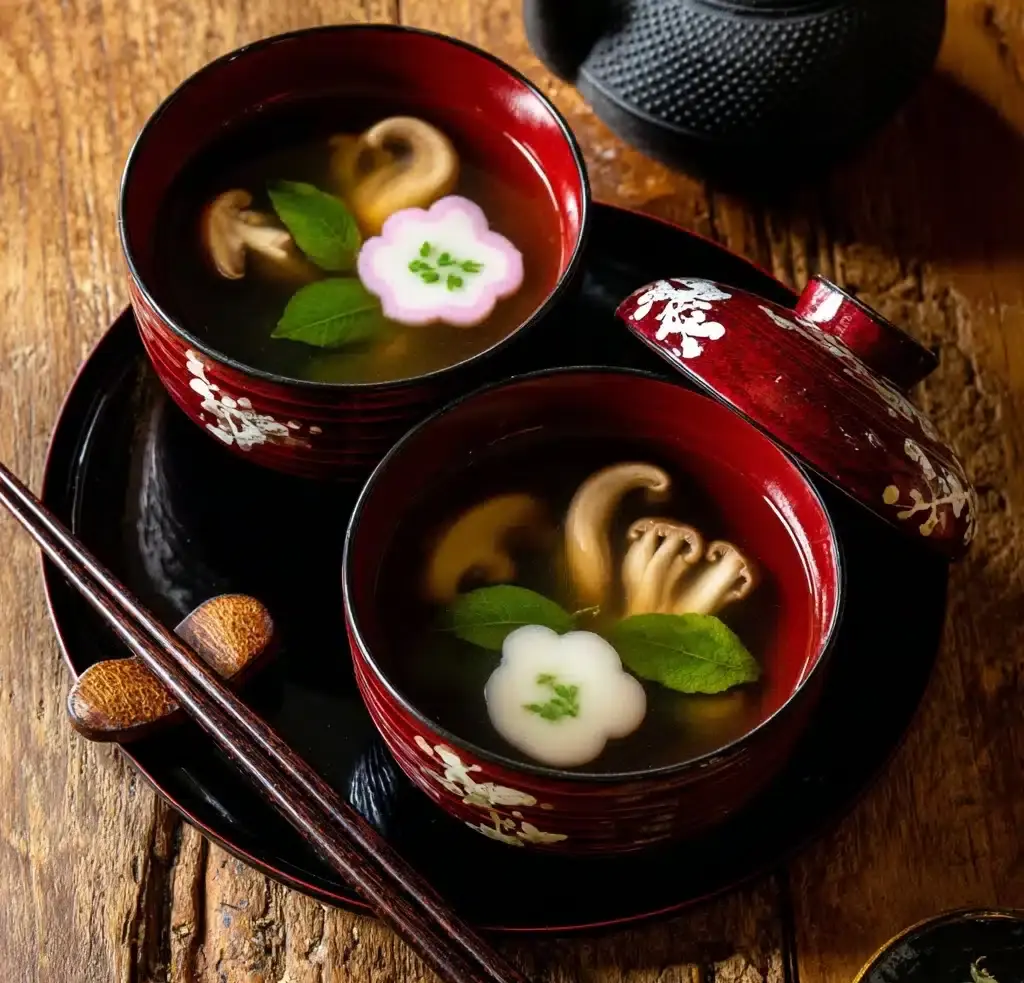Japanese Clear Soup (Osumashi) Recipe
If you’ve ever craved something that feels like a warm, gentle hug in a bowl, then you absolutely must try Japanese Clear Soup (Osumashi). This delicate broth strikes the perfect balance between simplicity and elegance, offering a clean yet deeply umami-packed flavor that soothes the soul. With a shimmering clarity and subtle layers from kombu, katsuobushi, and light soy sauce, this soup showcases the art of Japanese cooking in its purest form. Every spoonful transports you to a peaceful moment, highlighting how humble ingredients can combine to create something truly special.

Ingredients You’ll Need
The magic of Japanese Clear Soup (Osumashi) lies in its beautifully simple ingredient list. Each component is essential, bringing its own texture, flavor, or color to the bowl, ensuring the soup feels balanced and refined.
- Dashi (3⅓ cups): This Japanese soup stock is the heart of the broth, traditionally made from kombu and katsuobushi for rich umami depth.
- Usukuchi soy sauce (2 tsp): A lighter soy sauce that seasons without overpowering, adding that delicate hint of saltiness and color.
- Kosher salt (½ tsp): Enhances all flavors subtly, making the broth taste just right.
- Kamaboko (8 slices): This fish cake adds a slight sweetness and lovely pink-white color contrast in the soup.
- Fu (8 pieces): Wheat gluten that soaks up the broth beautifully, adding a chewy texture; perfect for traditional presentation.
- Shiitake mushrooms (2): Thinly sliced, they contribute earthiness and a meaty bite.
- Mitsuba (4 sprigs): Japanese parsley that offers a fresh, bright herbal note and a pop of green color.
- Water (4 cups): The base you start with to make your dashi.
- Kombu (1 piece, 10g): Dried kelp that dissolves subtle sea flavors and umami into the stock.
- Katsuobushi (1 cup): Dried bonito flakes that infuse the broth with smoky, savory notes.
How to Make Japanese Clear Soup (Osumashi)
Step 1: Prepare the Awase Dashi
Start by gently soaking the kombu in water for at least 30 minutes. This slow steep pulls out rich umami without bitterness. Warm the water with the kombu slowly just before boiling, then remove the kombu carefully to avoid off-flavors. Add your katsuobushi, bring to a brief boil, then let it steep until the bonito flakes sink to the bottom. Strain, and your clear, flavorful dashi stock is ready—the true soul of Japanese Clear Soup (Osumashi).
Step 2: Prep Your Soup Ingredients
Next, soften the fu by soaking it in water, slice the shiitake mushrooms delicately, knot the mitsuba stems for a charming visual, and slice the kamaboko into thin, elegant pieces. This prep is key to layering textures and visual appeal while keeping the soup light and fresh.
Step 3: Assemble and Warm Your Soup
Combine 3⅓ cups of your dashi with usukuchi soy sauce and a pinch of kosher salt in a pot. Gently add the kamaboko slices and shiitake mushrooms, warming the broth without boiling to keep its clarity. Place the fu and mitsuba into individual serving bowls, then ladle the clear soup over them. This method keeps the textures distinct and inviting.
How to Serve Japanese Clear Soup (Osumashi)

Garnishes
The beauty of Japanese Clear Soup (Osumashi) shines brightest with thoughtful garnishes. Adding fresh mitsuba sprigs delivers a refreshing herbaceous note, while the light pink kamaboko provides a visually delightful contrast against the crystal-clear broth. These garnishes are simple but critical in elevating the experience beyond just taste.
Side Dishes
This clear soup pairs wonderfully alongside delicate dishes like steamed rice, lightly pickled vegetables, or a mild grilled fish. These accompaniments allow each element of your meal to complement rather than overwhelm the subtle flavors of the soup—perfect for a balanced Japanese-inspired meal.
Creative Ways to Present
For a special touch, consider serving Japanese Clear Soup (Osumashi) in elegant lacquerware or traditional Japanese bowls to amplify its refined simplicity. Adding small, colorful edible flowers or a thin ribbon of yuzu peel can also bring an unexpected pop of flavor and artful charm that delights the senses.
Make Ahead and Storage
Storing Leftovers
If you find yourself with extra soup, cool it to room temperature before transferring to an airtight container. Store in the refrigerator for up to 2–3 days. Keep fresh mitsuba and wheat gluten separate, adding them just before serving to maintain freshness and texture.
Freezing
This soup’s delicate nature means freezing is not ideal, as the texture and clarity can be compromised. It’s best enjoyed fresh or within a couple of days refrigerated.
Reheating
Reheat your soup gently on low heat without boiling to preserve the clear broth and delicate flavors. Avoid microwaving, which can cause uneven heating and cloudy broth.
FAQs
Can I make Japanese Clear Soup (Osumashi) without fish products?
Absolutely! You can prepare a vegan dashi using kombu and dried shiitake mushrooms instead of katsuobushi. This keeps the soup rich in umami without animal products.
Is usukuchi soy sauce necessary for this recipe?
Usukuchi soy sauce is preferred for its lighter color and subtly salty flavor, which won’t darken the broth. However, if unavailable, a light touch of regular soy sauce can work, adjusting quantity to taste.
Can I substitute fu (wheat gluten) for a gluten-free option?
If gluten is a concern, feel free to omit fu or replace it with other delicate textures like soft tofu, although this will slightly alter the traditional experience of the dish.
How long can I steep kombu for dashi?
Steeping kombu for at least 30 minutes is essential, but longer times—up to several hours or overnight in the fridge—can deepen flavor, especially in colder seasons.
What else can I do with the spent kombu and katsuobushi?
Don’t throw them away! The used kombu can be simmered into a savory side dish called Kombu Tsukudani, while spent katsuobushi can be incorporated into rice seasoning blends or used to enrich compost for your garden.
Final Thoughts
Making Japanese Clear Soup (Osumashi) at home is a rewarding way to experience Japan’s culinary elegance firsthand. This soup may be simple, but it captures a remarkable depth of flavor and warmth that few dishes can match. Whether served as a starter or a light meal, it invites you to savor the quiet beauty of food made with care and tradition. Give it a try—you might just find this delicate broth becoming one of your most cherished recipes.
PrintJapanese Clear Soup (Osumashi) Recipe
Japanese Clear Soup, or Osumashi, is a delicate and flavorful broth made from dashi stock, lightly seasoned with usukuchi soy sauce and salt, enhanced with traditional ingredients like kamaboko fish cake, fu (wheat gluten), shiitake mushrooms, and mitsuba (Japanese parsley). This soup is perfect as a light appetizer or a comforting dish that showcases the umami flavors of Japanese cuisine.
- Prep Time: 15 minutes (plus 30 minutes to 4 hours for dashi steeping)
- Cook Time: 15 minutes
- Total Time: 45 minutes to 4 hours 30 minutes
- Yield: 4 servings 1x
- Category: Soup
- Method: Simmering
- Cuisine: Japanese
- Diet: Low Fat
Ingredients
Dashi Stock
- 3⅓ cups dashi (Japanese soup stock) (Awase Dashi made with kombu and katsuobushi; use vegan dashi for vegan/vegetarian option)
- 4 cups water
- 1 piece kombu (dried kelp) (10 g; 4 x 4 inches, 10 x 10 cm per piece)
- 1 cup katsuobushi (dried bonito flakes) (packed)
Soup Seasonings
- 2 tsp usukuchi (light-colored) soy sauce (use gluten-free soy sauce for gluten-free option)
- ½ tsp Diamond Crystal kosher salt
Soup Ingredients
- 8 slices kamaboko (fish cake) (omit for vegan/vegetarian option)
- 8 pieces fu (wheat gluten) (omit for gluten-free option)
- 2 shiitake mushrooms
- 4 sprigs mitsuba (Japanese parsley)
Instructions
- Prepare Dashi Stock: Soak 1 piece kombu in 4 cups water and steep for at least 30 minutes or up to 4–5 hours (cold brew overnight if preferred). Slowly heat the water and kombu over medium-low heat until just before boiling (about 10 minutes), then remove kombu. Add 1 cup katsuobushi, bring to a boil again, then simmer for 30 seconds and turn off heat. Let katsuobushi settle for 10 minutes.
- Strain Dashi: Strain the broth through a fine-mesh sieve into a bowl, discarding or saving the kombu and katsuobushi for other uses.
- Prepare Soup Ingredients: Soak fu (wheat gluten) in water for 10 minutes, then gently squeeze out excess water. Remove and discard shiitake stems, then thinly slice mushrooms about ¼ inch thick. Tie mitsuba stems into knots and slice kamaboko into thin ⅛ inch slices.
- Assemble Soup: Divide fu and mitsuba evenly into serving bowls. Return 3⅓ cups dashi to the pot, season with 2 tsp usukuchi soy sauce and ½ tsp kosher salt. Add kamaboko slices and shiitake mushrooms; heat gently until warm.
- Serve: Pour the hot broth with ingredients into the bowls over the fu and mitsuba. Serve immediately and enjoy the delicate flavors of this classic Japanese clear soup.
Notes
- Dashi requires a minimum steep time of 30 minutes but benefits from longer steeping for richer flavor.
- Fu (wheat gluten) and kamaboko (fish cake) are optional ingredients to accommodate dietary needs.
- Ingredients such as dense root vegetables or leafy greens should be pre-cooked separately before adding to the clear soup.
- Spent kombu and katsuobushi can be repurposed to make simmered kombu (kombu tsukudani) or other dishes.
- Store soup in the refrigerator for 2–3 days; add mitsuba and fu just before serving to retain texture and flavor.
Nutrition
- Serving Size: 1 cup (about 240 ml)
- Calories: 60
- Sugar: 1g
- Sodium: 650mg
- Fat: 1g
- Saturated Fat: 0.2g
- Unsaturated Fat: 0.6g
- Trans Fat: 0g
- Carbohydrates: 6g
- Fiber: 1g
- Protein: 5g
- Cholesterol: 10mg
Keywords: Japanese clear soup, Osumashi, dashi, kamaboko, fu, shiitake mushrooms, mitsuba, light soup, umami broth








